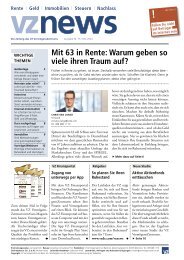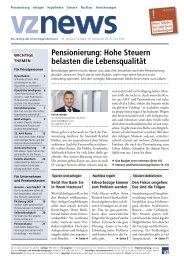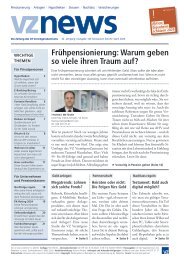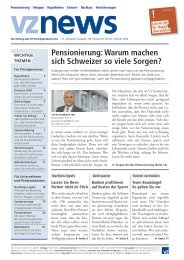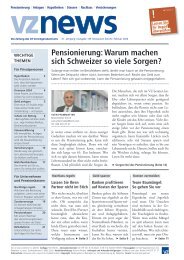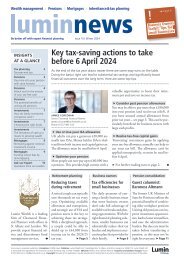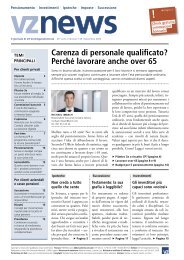lumin news Issue 6 / Autumn 2022
Create successful ePaper yourself
Turn your PDF publications into a flip-book with our unique Google optimized e-Paper software.
<strong>lumin</strong> <strong>news</strong> 6 / autumn <strong>2022</strong> Page 11<br />
Preserve pension assets and free up cash<br />
trapped in the family home<br />
Unlocking tax-free cash tied up in the family home can help reduce inheritance tax<br />
liabilities and release cash for important expenditures, including helping children<br />
onto the property ladder.<br />
PETER FLOWERS<br />
Senior Financial Consultant<br />
peter.flowers@<strong>lumin</strong>wealth.co.uk<br />
Phone 01727 893 333<br />
Do you have large pension<br />
assets and substantial wealth<br />
tied up in the family home?<br />
Are you looking to help<br />
children onto the property<br />
ladder, fund your own expenses,<br />
or take measures to<br />
reduce your inheritance tax<br />
(IHT) liabilities? If so, equity<br />
release could be a good<br />
solution, as property is part<br />
of the estate for IHT purposes,<br />
but pensions are not.<br />
What is equity<br />
release?<br />
Equity release frees up taxfree<br />
cash that’s tied up in<br />
your property, while you<br />
continue to live in your<br />
home. The most common<br />
form of equity release is a<br />
lifetime mortgage. This sees<br />
a cash loan secured against<br />
your main residence. The<br />
minimum age is 55 and the<br />
older you are, the more you<br />
can borrow. The tax-free<br />
cash can either be taken as<br />
a lump sum, or in flexible<br />
chunks. The original loan<br />
and accumulated interest<br />
is then repaid via proceeds<br />
from the property sale when<br />
the last partner either dies or<br />
moves into long-term care.<br />
Equity release myths<br />
Many myths still exist, even<br />
though lifetime mortgages<br />
are very different from<br />
certain historical equity<br />
release products that gave<br />
the industry a bad reputation.<br />
Modern products<br />
offer much more flexibility<br />
and protection for consumers.<br />
One misconception is<br />
How equity release can cut IHT liabilities<br />
Assumptions: Family with total assets of £4,000,000; figures rounded.<br />
Current<br />
situation<br />
With equity<br />
release and gift<br />
Property £2,000,000 £1,500,000<br />
Pensions £1,500,000 £1,500,000<br />
ISAs/non-pension assets £500,000 £500,000<br />
Total wealth £4,000,000 £3,500,000<br />
IHT estate £2,500,000 £2,000,000<br />
NRB/RNRB £750,000 £1,000,000<br />
Potential IHT liabilities 1 £700,000 £400,000 2<br />
1 Based on current allowances, exemptions and 40% tax rate<br />
2 If the gift (in this example £500,000) is survived for at last 7 years;<br />
otherwise potential IHT liabilities are not mitigated<br />
that you forfeit total home<br />
ownership, when in fact<br />
you maintain 100% ownership.<br />
It’s also often possible<br />
to move house and transfer<br />
your lifetime mortgage.<br />
Others worry their children<br />
might inherit debt, but ‘no<br />
negative equity guarantees’,<br />
which are offered by Equity<br />
Release Council-approved<br />
providers, mean your estate<br />
will never owe more than<br />
the value of your home.<br />
Reducing<br />
IHT liabilities<br />
For many families, property<br />
accounts for a large chunk<br />
of household wealth. Freeing<br />
up tax-free cash from<br />
the family home via equity<br />
release can mitigate a large<br />
IHT liability and provide<br />
flexibility when passing<br />
wealth on to beneficiaries.<br />
IHT bills can be large,<br />
even when available nil-rate<br />
band (£325,000 per person)<br />
and main residence<br />
nil-rate band (£175,000 per<br />
person) allowances are applied.<br />
In the example (left)<br />
the ‘current situation’ shows<br />
the liability a family with<br />
£4,000,000 in assets face.<br />
Pensions aren’t part of the<br />
estate for IHT purposes,<br />
so the total taxable estate is<br />
£2,500,000. When an estate<br />
is valued at £2,000,000+,<br />
the residence nil-rate band<br />
tapers away by £1 for every<br />
£2 above £2,000,000,<br />
meaning £250,000 of the<br />
£350,000 residence allowance<br />
is lost.<br />
An IHT charge of 40%<br />
on the taxable assets results<br />
in a tax liability of £700,000.<br />
In the other scenario, a<br />
£500,000 equity release<br />
lifetime mortgage is implemented,<br />
and this tax-free<br />
lump sum is gifted to family,<br />
reducing the taxable part of<br />
the estate by £500,000. Because<br />
the full nil-rate band<br />
allowances are now available,<br />
this reduces the IHT liability<br />
by £300,000. Implementing<br />
equity release and using the<br />
proceeds to gift to children<br />
can be a good way of reducing<br />
IHT bills while providing<br />
funds for first-home<br />
purchases. Gifts of more<br />
than £3,000 may be subject<br />
to an IHT charge if you pass<br />
away within seven years.<br />
Equity release is a big<br />
decision and it’s advisable<br />
to involve your family.<br />
An independent financial<br />
adviser can help you<br />
identify the solution that<br />
best suits your needs. Call<br />
the team on 03300 564 446<br />
to find out more.<br />
Important: Equity released<br />
from your home will be<br />
secured against it.<br />
FACTSHEET/WEBINAR<br />
When is equity<br />
release a<br />
good idea?<br />
Request a free factsheet or<br />
join our webinar (see page<br />
12). Email info@<strong>lumin</strong>wealth.co.uk,<br />
or call the<br />
team on 03300 564 446





